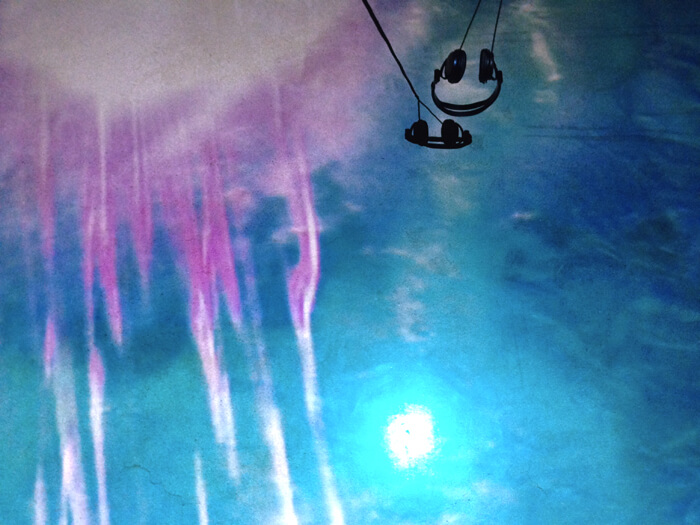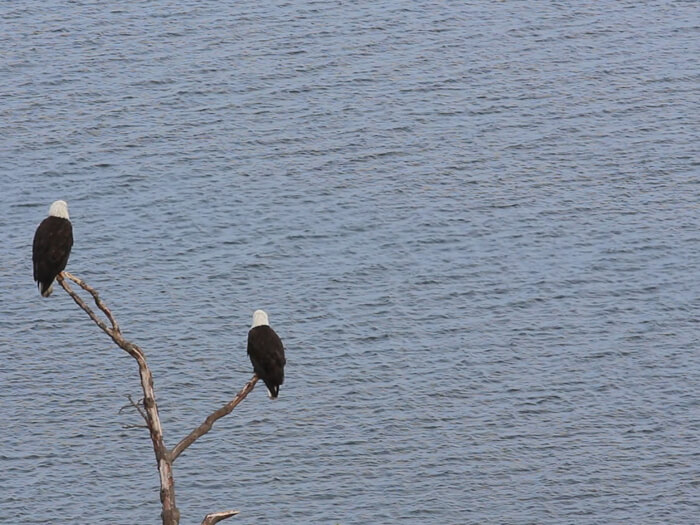Words by Meritxell Rosell

Yolande Harris is a composer, visual artist and academic who aims to reinterpret from a post-humanist perspective the techno-ecological spaces we are meant to inhabit. Post-humanism, seen as a human condition in which traditional humanistic paradigms collapse, relegates humanity back to one of many natural species and rejects the Anthropocene; human knowledge is reduced to a less controlling position, previously seen as the defining aspect of the world.
Expanding from performances, improvisation, and audio-video installations to field research and lectures, Harris’ work entwines a practical approach with her conceptual theories of techno-intuition and sonic consciousness, seeking to raise awareness about our environment through technology and critical listening. Her impressive academic qualifications – she holds degrees in Art History and Music, an M.Phil. in Architecture and Moving Image and a PhD in Sound Art – have given her a broad but also deep knowledge bringing about her distinctive perspective.
For her projects, she uses sonification of data, techniques of navigation, and underwater bioacoustics and blends them in a sort of aquatic psychogeography, exploring the possibility of widening architectural space by means of audiovisual expression.
Pieces like the video installation Pink Noise (The Pink Noise of Pleasure Yachts in Turquoise Sea) which uses sound recorded underwater at a National Marine Reserve: sounds of boat engines, anchors and sounders blended with video shootage of colourful light reflecting on the sea from the same location.
Sun Run Sun:on Sonic Navigations, in which a changing musical composition is generated from signals of GPS, exploring the personal experience of location and navigation through sonification. In Eagle, she uses the sound of a robotic sea-glider and images and video recordings of eagles and the sea to explore these techno-spaces and blur the boundaries with the perceived reality. The eagle serves as a guide through this journey.
Scorescapes is her thesis research project and an ambitious workpiece that brings together all her creative and intellectual universe. It includes some of her works like Tropical Storm, Pink Noise, Fishing for Sound, Swim, S.W.A.M.P… A study that goes beyond performances, installations and graphic images with walks and writings and analysis of texts, scientific papers and personal experiences. An attempt to understand sound’s role in environmental changes from a kaleidoscopic myriad of angles.
Having studied with pioneers of sound art of the likes of Alvin Lucier, Pauline Oliveros and Peter Sculthorpe, she proposes a radical musical view and uses technology in her work as the means through which to understand the electronically extended spaces we are confined to live in.

Your work involves sound, technology and the natural world. When and how did the fascination with them come about?
As a child, I connected to the natural world easily and deeply. We lived in a remote house on the cliff land in Devon (UK), and it was there that I developed a profound affinity with the local environment. My family is deeply connected to the sea, and my childhood was filled with boats, ocean swimming, and sailing with my three brothers.
I also enjoyed going on-site visits with my architect parents to dilapidated historic buildings and helping with architectural plans on their drawing board. Such experiences helped me cultivate sensitivity to a sense of place, specific sites and an analytical, technical way of thinking about them.
Sound entered my life through music when I began classical flute and piano as a child. It came easily to me, so I progressed rapidly and got lost in the complexities of the sounds in ways that would take over my being.
At times, technology and the natural world seem like the antithesis of each other, opposite poles that cannot meet. But my experiences growing up helped me to intuitively draw them together through my practical understanding of boats, navigation, musical instruments and architectural spaces. I came to understand through sailing, for example, how to read the weather, the water and the motion of the boat in my body.
I developed both an intellectual and corporeal awareness and sensitivity to the subtle changes in the environment, wind, temperature, sounds, and other living beings. Learning to control and perform with a boat – an instrument if you like – demanded that I commit to practice this constant interchange between my body and the environment, much as I did by learning musical instruments. As an adult, I wanted to understand the potential of digital technology to be played, respond and work with this kind of attuned physicality in the environment, and so enhance rather than bury our intuitive physicality – what I now call techno-intuition.
What are your aims as a sound artist working in between technology and art?
My aim is to re-awaken and enliven our senses through a critical use of sound, image and technology to create a space to experience our natural environments intensely. The practice of looking and listening, while often extended and meditated by technology, is rooted in our individual bodies and our mental attention. And sound can only really affect us in combination with the other senses.
In my work I explore this everyday synesthetic space, where we understand the world around us by allowing our senses to work together to influence our perception. I create environments where the audio and the visual play off each other, often contrasting to suggest unexpected meanings, such as the video of eagles combined with the sound of a robotic sea-glider in the installation Eagle (2015).
So my work really responds to what I see as a necessity – to re-enliven our relationship to our local environments and to re-kindle a felt sense of ecological interconnectedness. I offer experiences of environmental conditions displaced into art settings that aim to enrich a sense of bodily consciousness and connectedness.
My work encourages people to become sensitive to our environment by learning and listening, embedding ourselves within it. Although technology can dis-locate us, it can bring something from distant places into our experience, into our hearing range, and so into our consciousness. My hope is that this can expand awareness and empathy and start the healing process towards the earth.
In Listening to the Distance, you use high tech methods to bring awareness of natural and “distant” sounds, which seem to be shut out by contemporary urban spaces. What were the biggest challenges you faced for its development?
How do we project ourselves into vast distant spaces? How do we bring such spaces closer in order to understand them through our technologies and through our minds? My solo exhibition, Listening to the Distance, joined multiple works in the same large space and explored their interconnections.
Video, prints, sound and drawings combine throughout the spaces; sounds draw you from one end to another, while lighting leads your eyes to move through distant rooms. Hanging headphones act like spatial anchors in this drifting environment, opening up private sound worlds that encourage a different kind of imaginative drift.
One challenge I faced was trusting my own senses and intuitions! It was hard, first, to recognize, and then to deeply understand, the possibility of becoming and absorbing a quality of ‘eagleness’ and honoring that knowledge through my work. In Listening to the Distance, the eagle, the whale, and the underwater robot drone, are all brought closer to us, up against our ears and our eyes.
They imaginatively launch us into the distance, into flight, into the deep ocean. In my work, I tap into the well of knowledge about human relationships with animals, birds and the non-human world. I celebrate this more than the technology itself, which I treat as just one way to access these other worlds.
Every time I lower a hydrophone into the water and listen through headphones, I am astonished by the otherworldliness of what I hear. As if the membrane of the surface and the different substances of these two media – air and water – contain entirely different and separate worlds.
The unfamiliar sounds I hear often come from a source I cannot see, making it harder to understand the relationship between the sound and the life in the water environment. And yet sometimes that sense of otherness is transformed as one sound leaks across from the air to the water: I see a boat passing by and hear the vibration of its engines through the water, transformed but distinct.
In my installation Pink Noise (2010), I worked with this ambiguous area between seeing and hearing above and below water. As you stand in a pool of pink and turquoise water reflecting surface light, you hear through headphones the otherworldly sounds of loud boat engines, depth sounders and anchors dropping – the juxtaposition and synthesis of these two simultaneous perceptions is what I’m interested in – waking up the awareness of visitors to this otherness in our everyday environments and our human effect on these environments that we cannot otherwise perceive.
So the most challenging part of this kind of work is to open our perceptions to environments that are radically different from ours, to encourage others to listen and bring these other worlds into our more common everyday experience.
Sound and listening fundamentally relate us to another being or object by perceiving their vibrations. It is this level of relationship that is stirred in me when I have the opportunity to listen to sounds that are otherwise inaudible (bats, whales, satellites).
This experience attunes me to a more heightened awareness of my position within larger systems and ecologies, what I refer to as sonic consciousness. Ultimately it offers a chance to heal our relationship with environments that are already damaged through pollution and a lack of knowledge.
Solitude or loneliness, how do you spend your time alone?
I am very good at daydreaming …
What is your chief enemy of creativity?
Too much work… Being indoors too much…
You couldn’t live without…
A view into a distance, space to see the stars. Fresh air, clean water. Love and kindness. A flute of some kind. My ‘Cricket’ camper (although a small boat could possibly substitute).






